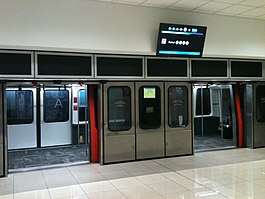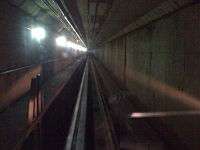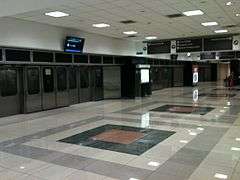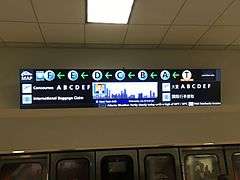The Plane Train
The Plane Train is an automated people mover (APM) at Hartsfield–Jackson Atlanta International Airport that transports passengers between the terminals and the airside concourses. The system is the world's most heavily traveled airport APM, with 64 million riders as of 2002.[2]
| The Plane Train | ||||||||||||||||||||||||||||||||||||||||||||||||||||||||||||||||||||||||||||||||||||||||||||
|---|---|---|---|---|---|---|---|---|---|---|---|---|---|---|---|---|---|---|---|---|---|---|---|---|---|---|---|---|---|---|---|---|---|---|---|---|---|---|---|---|---|---|---|---|---|---|---|---|---|---|---|---|---|---|---|---|---|---|---|---|---|---|---|---|---|---|---|---|---|---|---|---|---|---|---|---|---|---|---|---|---|---|---|---|---|---|---|---|---|---|---|---|
 | ||||||||||||||||||||||||||||||||||||||||||||||||||||||||||||||||||||||||||||||||||||||||||||
 Concourse A Station | ||||||||||||||||||||||||||||||||||||||||||||||||||||||||||||||||||||||||||||||||||||||||||||
| Overview | ||||||||||||||||||||||||||||||||||||||||||||||||||||||||||||||||||||||||||||||||||||||||||||
| Type | People mover | |||||||||||||||||||||||||||||||||||||||||||||||||||||||||||||||||||||||||||||||||||||||||||
| Locale | Hartsfield–Jackson Atlanta International Airport | |||||||||||||||||||||||||||||||||||||||||||||||||||||||||||||||||||||||||||||||||||||||||||
| Termini | Domestic Terminal International Terminal | |||||||||||||||||||||||||||||||||||||||||||||||||||||||||||||||||||||||||||||||||||||||||||
| Stations | 8 | |||||||||||||||||||||||||||||||||||||||||||||||||||||||||||||||||||||||||||||||||||||||||||
| Daily ridership | 200,000[1] | |||||||||||||||||||||||||||||||||||||||||||||||||||||||||||||||||||||||||||||||||||||||||||
| Operation | ||||||||||||||||||||||||||||||||||||||||||||||||||||||||||||||||||||||||||||||||||||||||||||
| Opened | September 21, 1980 | |||||||||||||||||||||||||||||||||||||||||||||||||||||||||||||||||||||||||||||||||||||||||||
| Character | Underground subway | |||||||||||||||||||||||||||||||||||||||||||||||||||||||||||||||||||||||||||||||||||||||||||
| Rolling stock | 59 Bombardier Innovia APM 100 vehicles | |||||||||||||||||||||||||||||||||||||||||||||||||||||||||||||||||||||||||||||||||||||||||||
| Technical | ||||||||||||||||||||||||||||||||||||||||||||||||||||||||||||||||||||||||||||||||||||||||||||
| Line length | 2.8 mi (4.5 km) | |||||||||||||||||||||||||||||||||||||||||||||||||||||||||||||||||||||||||||||||||||||||||||
| ||||||||||||||||||||||||||||||||||||||||||||||||||||||||||||||||||||||||||||||||||||||||||||
History

The Plane Train opened along with the current airport terminal on September 21, 1980. The system was jointly built by Westinghouse Electric and Adtranz, who supplied the system's initial fleet of C-100 vehicles. The initial system consisted of the six stations from the terminal (now the Domestic Terminal) up to Concourse D.
In 1994, the system was extended with a new station for Concourse E (which was constructed for international flights in preparation for the 1996 Summer Olympics in Atlanta) and trains lengthened from three cars to four.[3]
In 2002, Bombardier Transportation, which had recently acquired Adtranz, replaced the system's original C-100 vehicles with new Innovia APM 100 vehicles.
Having operated without an official name since its opening, the system was officially given its current name of "The Plane Train" on August 10, 2010.[4]
In 2012, the Maynard Holbrook Jackson, Jr. International Terminal and Concourse F opened along with another extension of the Plane Train. Ten additional vehicles were added to the system to accommodate this expansion, bringing the total number of Innovia APM 100 vehicles in the system's fleet to 59.[5]
Operations
The Plane Train operates in two tunnels bracketing the pedestrian walkway in the airport's Transportation Mall. The system has eight stations that are all within the secure area of the airport, one at each of Concourses A, B, C, D, E, and F (International Terminal), and two in the Domestic Terminal – one at Concourse T, which is also the station for passengers from the Domestic Terminal heading to Concourses A–F, and one at domestic baggage claim and ground transportation.
The Domestic Baggage Claim station, and stations for concourses T, E, and F have island platforms shared between the two tunnels, while stations at concourses A, B, C, and D each have separate platforms servicing each tunnel. Displays on the platforms announce the time of arrival for the next train and its destination. Each door on the platform also has a set of red lights that flash alternately to warn that the doors are closing, a feature present since the 1980s.
Because the train operates inside the secure area of the airport, arriving passengers ending their journeys at the International terminal cannot use the train and must instead take a lengthy ground transportation detour around the perimeter of the airport to access facilities such as the car rental centre or MARTA station. (Departing international passengers entering the International Terminal may use the train to access concourse E or the other concourses.)
Inside the trains, color video displays provide station information in eight languages (English, French, German, Spanish, Japanese, Chinese, Arabic, and Korean) as well as information about dining and shopping options in the concourses. The original displays were English text-only dot-matrix red-LED displays, replaced before the Olympics with larger ones having a smaller dot pitch (and therefore higher resolution) capable of showing eastern Asian CJK characters.
Audible announcements deliver station information and warn passengers of the train's movements. The messages use the NATO phonetic alphabet to identify each concourse station. For example, the message announcing Concourse B says: "Welcome aboard the Plane Train. The next stop is for B Gates. B, as in Bravo." The one exception to this is Concourse D, which uses the APCO radiotelephony spelling alphabet where "David" is used rather than "Delta" to avoid confusion with Delta Air Lines, which operates its main hub at ATL.
The audio announcements on the Plane Train have been delivered by five different voices throughout its history. Originally, the trains featured a monotone male synthesized voice. This was later replaced with a recorded male voice in conjunction with the extension to Concourse E in 1994; at the same time, sound effects were added. New announcements that debuted in 2002 when the vehicles were replaced did away with the sound effects and were provided by local voice talent Bill Murray[6] (not to be confused with actor/comedian Bill Murray). In 2006, new recordings using the phonetic alphabet were provided using the voice of Susan Bennett, who is the voice of Delta Air Lines gate boarding announcements at the airport and who has since become famous for being the voice of Siri.[7]
The current announcements, which debuted in March 2012, are provided by voice actress Sharon Feingold,[8] who also provides those for the ATL SkyTrain. They are the first to not use the word "concourse", instead referring to the concourse stations with the word "gates", e.g. "A Gates". They also added the name of the train, returned sound effects, and added announcements for the International Terminal and Concourse F.
While the in-vehicle voice changed throughout the years, the male voice continued to be used in the stations (including the Concourse F station when it first opened) during 1995–2002 to alert passengers when the doors close, by stating, "Careful. Doors are closing and will not reopen. Please wait for the next train," after a chime plays. This message has been updated with a new male voice and sound effects similar to the in-vehicle chime.
The end of the line is Concourse F / International Terminal. During peak hours, the trains will stop at the eastbound side of the platform, unload, and then proceed further to a cross-over track to return to the westbound side of the platform. During non-peak hours, trains cross-over prior to reaching the platform and arrive/depart from the westbound Concourse F platform.
Gallery
 Concourse C eastbound platform
Concourse C eastbound platform Platform information display
Platform information display- In-vehicle information display
See also
References
- "ATL Fact Sheet". Hartsfield–Jackson Atlanta International Airport. Retrieved February 5, 2017.
- "Transportation Mall/People Mover". Hartsfield–Jackson Atlanta International Airport. Archived from the original on February 19, 2007. Retrieved July 6, 2007.
- "Airport History". Hartsfield–Jackson Atlanta International Airport. Archived from the original on February 21, 2003. Retrieved August 27, 2008.
- "Hartsfield people mover = The Plane Train". Atlanta Business Chronicle. August 10, 2010. Retrieved August 10, 2010.
- "INNOVIA Automated People Mover System - Hartsfield-Jackson Atlanta International Airport". Bombardier Transportation. Archived from the original on May 30, 2013. Retrieved February 5, 2017.
- Bill Murray Voices, Inc.
- "SUSAN C. BENNETT - VOICES & VOCALS". Archived from the original on February 20, 2012. Retrieved April 9, 2012.
- "Sharon Feingold voiceovers". Voiceography. Retrieved April 28, 2015.
External links
| Wikimedia Commons has media related to The Plane Train. |